
By Tony Martins
Walking up to the Nikon Sport Optics booth at the 2018 SHOT Show, I was surprised to find the company was introducing another new rangefinder (actually, two). Similar in appearance and functionality to the Monarch 7i VR that debuted just one year earlier, the new Nikon Monarch 3000 Stabilized Laser Rangefinder was described as a “… further improved model of the 7i VR.” As one of the first to review and extensively field-test its predecessor that featured ground breaking optical vibration reduction (VR) technology, I was eager to get my hands on one of the new “improved” units.

It has been my good fortune to live in the White Mountains in eastern Arizona – famous for producing giant bull elk – for the past 25+ years. My hour-long daily commute, through some of the more game-rich country in the state, provides ample opportunity to test optics in a variety of weather and simulated hunting conditions. Elk, deer and pronghorn can be observed everyday, with occasional sightings of bighorn sheep, black bear, wolves and coyotes. Over the past 90 days, I have ranged nearly 1000 animals with the Monarch 3000 Stabilized, and find it to be an excellent, full-featured rangefinder for all but the longest, long-range hunting applications.
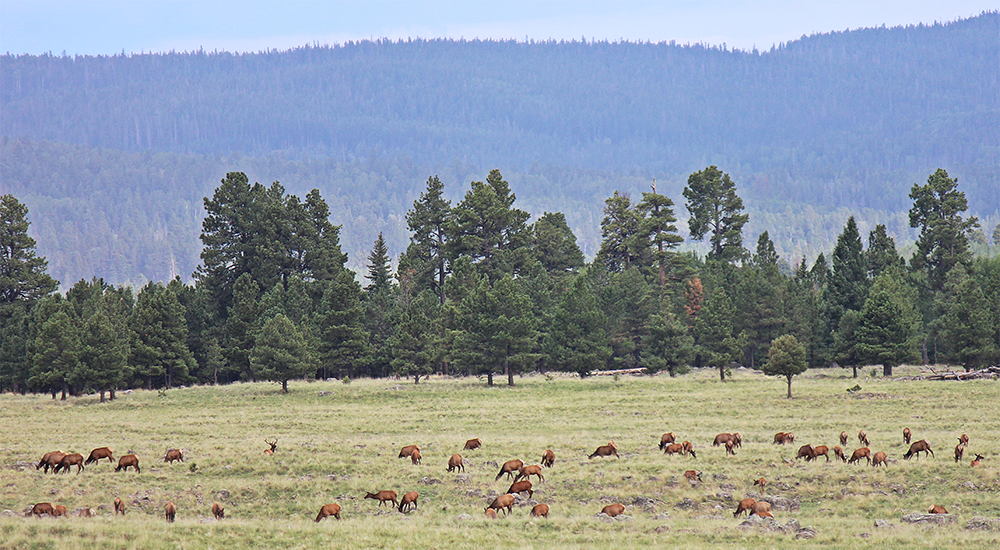
In previous rangefinder reviews I’ve noted that rangefinders can be categorized by two main parameters, cost and functionality (or intended use). Grouping by cost we have economy class (under $200.00) and premium class (over $600.00) models, and everything in between. This last one can be called the “basic” class, and with an MSRP of $419.95 the new Monarch 3000 Stabilized (M-3000-S) is well placed here. Grouping rangefinders by functionality is a more interesting approach, with four different categories – bow hunting, rifle hunting, multi-purpose hunting, and target shooting. Throughout this review features of the new M-3000-S will be discussed, while direct comparisons with the M-7i VR will be made, in relation to these applications categories.
The big news with last year’s M-7i VR was the VR = Vibration Reduction. By reducing the effect of external vibrations, the VR technology compensates for the physical inability of human hands and body to remain completely still. This inherent “sinusoidal wave” movement is reduced by 80% or more through stabilization technology that is similar to what Nikon has been using in their cameras and lenses for many years. The result for the photographer is sharper images. For the rangefinder user the resulting benefits include quicker, more precise targeting – particularly with small and distant objects – as well as sharper, steadier imaging in the viewfinder. Furthermore, the laser is also stabilized (by an internal gyroscope) when activated. This facilitates more precise alignment with the target and improves accuracy.
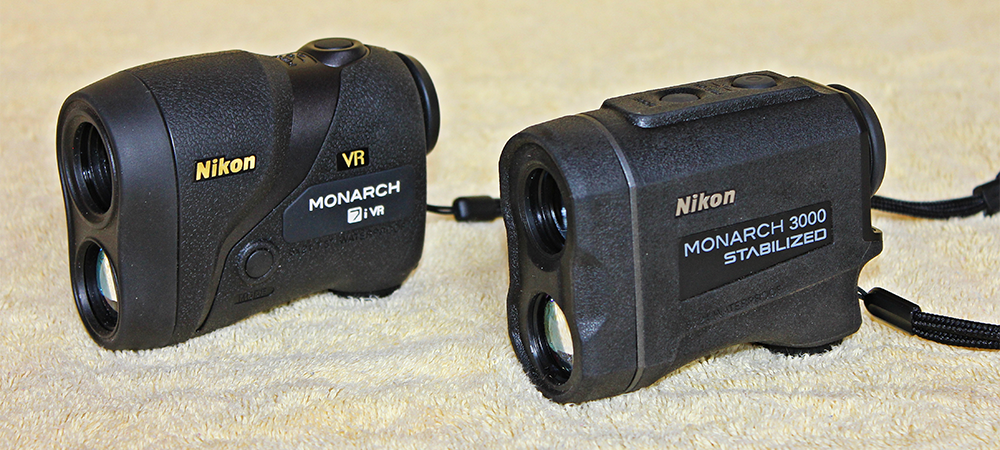
KEY FEATURES & FUNCTIONS
Introduction and background complete, let’s review the main features and functions of the new Monarch 3000 Stabilized rangefinder.
- As might be expected from the name, STABILIZED is the premier feature, and it functions as advertised! When an animal is ranged the target mark (cross hair) in the 6-power viewer remains stable, making it easier to hit the animal and obtain a distance reading, often on the first attempt. Most hunters have experienced the frustration of having to press the ranging button repeatedly to get a reading, which is common with many compact rangefinders. The M-3000-S image stabilization feature effectively eliminates this problem.
- A new red OLED internal display was added to enable easier viewing under any lighting conditions. One of the two biggest complaints about the M-7i VR was the plain black display, which was considered difficult to read in low light conditions. The M-3000-S offers 5 intensity settings, as well as an automatic brightness adjustment function that tunes display brightness according to the surrounding ambient light level. This feature is useful in all but the brightest and darkest conditions, where I found the display was easier to read when the highest (4 or 5) and lowest (1 or 2) intensity settings, respectively, were manually selected.
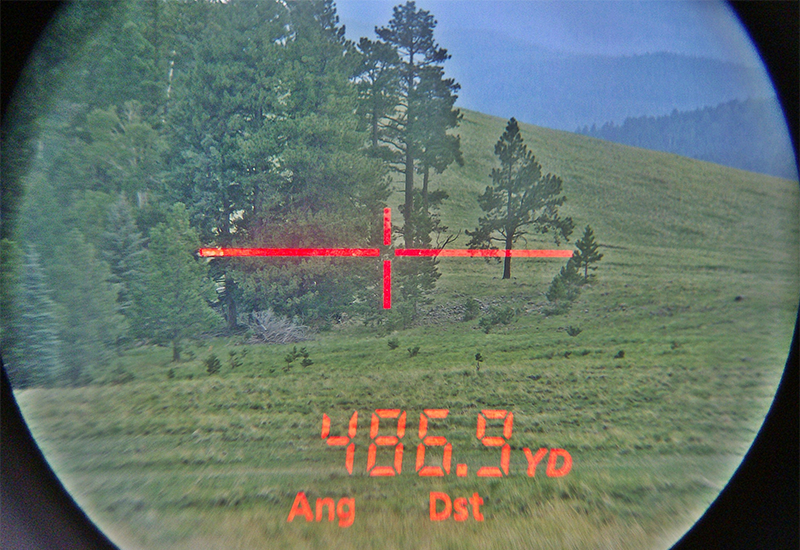
- Single or continuous measurement – Holding the ranging button down provides continuous measurement for up to 8 seconds. This feature facilitates measurement of moving targets and those that are difficult to hit. It is particularly useful for precise shot placement by bowhunters at close range.
- HYPER READ is Nikon’s name for the function that produces the measured response and displays the result in about 0.3 seconds, regardless of distance. This is super-quick – and even faster than the M-7i VR’s response time of 0.5 seconds. It is also probably unnecessary, and can actually pose a problem when the continuous measurement function is used on difficult to hit targets. Why? Because during continuous ranging your eye is focused on the target mark, so if a distance measurement appears, it flashes by too quickly for your eye to move down to where it’s displayed in the viewer so your brain can register the distance.
- Tru-Target Technology is Nikon’s term for first or last target priority. This feature is useful to both rifle and bow hunters for measuring overlapping subjects – like elk in timber – or when brush partially hides the target. I find that first priority mode works great for small, unobscured targets like prairie dogs. Last priority mode is particularly useful when reflective objects like rocks or tree trunks are closer than a less reflective target like a game animal.

- Nikon’s ID Technology (Incline/Decline) provides user selectable “actual” or “horizontal” distance to the target, compensating for uphill/downhill shot angles as steep as 89 degrees (up or down). This is an excellent feature that tested remarkably accurate. It’s especially useful for rifle hunters in mountainous terrain and bowhunters in treestands.
- Designed for single-handed operation, the compact body facilitates a steady and comfortable hold, with long eye relief that eyeglass wearers will appreciate. The on/off/ranging button is positioned on top, in tandem with the mode button, which was repositioned from its side-mount location on the M-7i VR. Measuring 3.8” x 2.9” x 1.7” (Length x Height x Width) and weighing only 6.9 oz. (without battery), the M-3000-S is both smaller and lighter than its predecessor. The new unit fits easily inside a shirt pocket, and carries almost unnoticed with the neck lanyard (included). Both fogproof and waterproof, it tested fully functional during light to moderate rainfall.
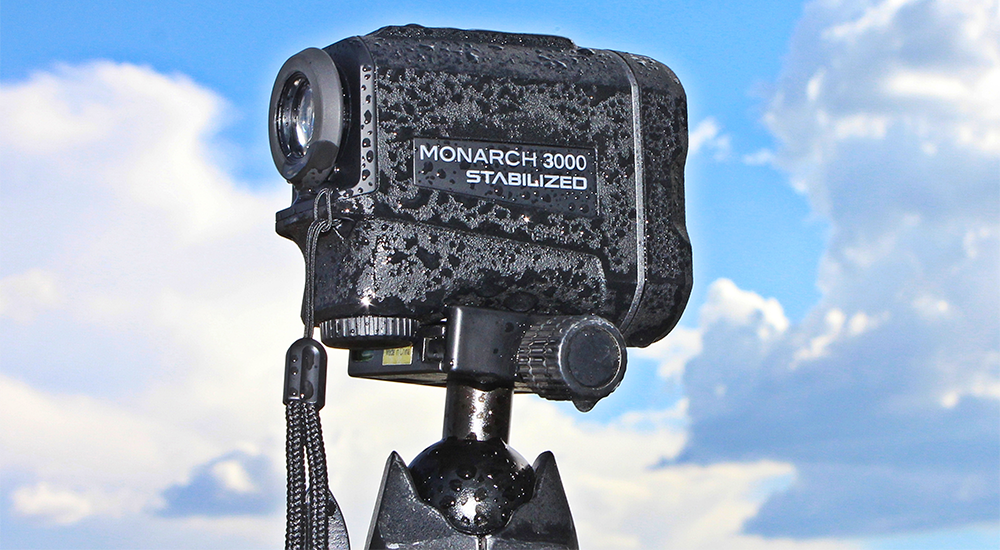
- Bright 6-power optics, large ocular (18mm), and a wide field-of-view (7.5 degrees) combine to facilitate viewing and quick target acquisition. And, image sharpness is enhanced with an adjustable diopter.
PERFORMANCE
OK, let’s get this out of the way up front: Just like the M-7i VR was not a 1000 yard rangefinder as advertised, the new M-3000-S is not a 3000 yard rangefinder. In fact, its distance measuring ability is not even close… To date, I have tested 3 different M-3000-S units, and although each would occasionally measure a broadside animal over 1000 yards distant under favorable atmospheric conditions (dry with ample ambient light) after repeated attempts, from a practical application perspective, this rangefinder is a functional 800 yard unit. More on this later, but for now it’s sufficient to point out that this issue is really more of a psychological problem than a functional problem – as the vast majority of hunters simply do not need to measure distances beyond 800 yards.
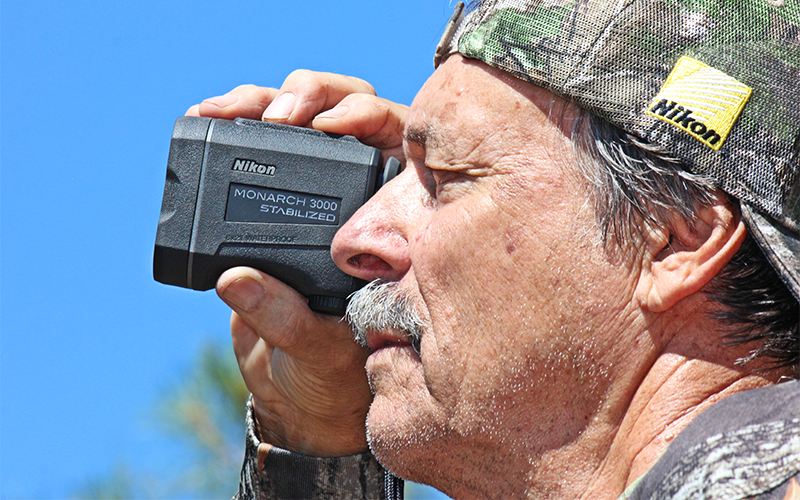
When considering a rangefinder purchase, it’s important to understand that the maximum ranging distance cited by the manufacturer is for ideal lighting and weather conditions on large, flat-sided, highly reflective targets – like a metal billboard or concrete building – and not for a target that will absorb or diffuse the laser pulse – like the dark-colored, furry body of an animal or the leaves of a tree. Thus, you can expect a model rated for 1000 yards to accurately range a stationary animal at least as far as 500 yards away. This distance is commonly known as the mid-point benchmark. Furthermore, the better the quality of the optics, power of the laser, and sensitivity of the receiver, the greater the effectiveness and range beyond this benchmark. Monarch 3000 Stabilized optics are multi-coated, bright and excellent quality. Without confirmation from Nikon, I suspect the M-3000-S laser is a little more powerful and/or the receiver is more sensitive than the M-7i VR.
Following are the longest distances I have ranged with the M-3000-S for animals and objects listed. Some required multiple attempts to obtain a measurement reading. Also please note that although attempts were made to assess the longest distance this unit would measure on prevalent animals like elk and beef cows (indicated by “max”), many of the listed distances do not necessarily represent the maximum this model will measure for the given target and atmospheric conditions. Note – distances were confirmed with readings from a Nikon LaserForce rangefinder/binocular:
| Target | Distance | Reflectiveness | Weather Conditions |
| Elk broadside | 847 yards (max) | low | clear & dry |
| Elk broadside | 823 yds – no reading | low | clear & dry / low light |
| Elk broadside | 717 yards (max) | low | light rain |
| Bull Elk – head only | 642 yards | low | overcast & dry |
| Bighorn Sheep | 694 yards | moderate | partly cloudy & dry |
| Pronghorn – walking | 803 yards | moderate | clear & sunny |
| Mule Deer – broadside | 775 yards | moderate | overcast & damp |
| Beef Cow – black | 441 yards | very low | partly cloudy & dry |
| Beef Cow – brown | 1051 yards (max) | moderate | partly cloudy & dry |
| Beef Cow – brown | 788 yards (max) | moderate | light rain |
| Coyote | 603 yards | moderate | partly cloudy & dry |
| Prairie Dog | 331 yards | low | clear & sunny |
| Dog – yellow lab | 396 yards | moderate | overcast & damp |
| Dog – chocolate lab | 314 yards | low | overcast & damp |
| Dog – black lab | 157 yards (max) | very low | overcast & damp |
| Blue Heron | 225 yards | low | clear & sunny |
| Building – concrete | 1178 yards | high | partly cloudy & dry |
| Water tank – metal | 1109 yards (max) | high | clear & sunny |
| Barn – metal | 998 yards | high | overcast & damp |
| Rock butte face | 1080 yards | high | partly cloudy & dry |
| Billboard – light metal | 874 yards | high | overcast & damp |
| Billboard – dark vinyl | 620 yards | moderate | partly cloudy & dry |
| Pine tree trunk – large | 777 yards | moderate | partly cloudy & dry |
| Pine tree trunk – large | 1070 yds no reading | moderate | partly cloudy & dry |
| Juniper tree foliage | 563 yards | low | partly cloudy & dry |
This data shows the M-3000-S will read beyond 1000 yards on highly reflective surfaces, and sporadically after multiple attempts on large animals under favorable weather/lighting conditions. Inside 500 yards, readings were quickly obtained on most animals, whether they were moving or not. It should be noted that at 500 yards the body of a broadside elk occupies the entire target mark area, while at 700 yards the target mark spans from head to tail. The clear, uncluttered and stabilized target mark facilitates alignment and first try measurement, with most readings on animals inside 700 yards coming on the first or second attempt while hand-holding the unit.
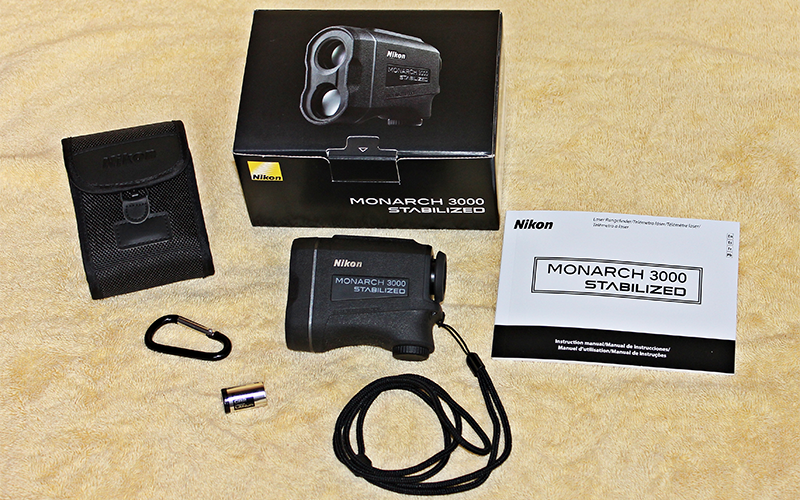
BEST FEATURES (What I Like)
- Stabilization – This headline feature lives up to the hype. It eliminates much of the frustration formerly associated with obtaining quick and accurate readings from compact laser rangefinders on difficult to hit targets.
- Continuous Ranging – The more I use this feature, the more I appreciate it. With distant, small and/or moving targets that I know will be difficult to hit, I typically hold the ranging button down while passing the target mark across the subject. This technique produces a reading almost every time on animals inside 700 yards.
- Angle Compensation – This feature is accurate and invaluable for hunters in situations where an uphill or downhill angled shot will be taken. I keep this feature turned-on to display the “horizontal” distance at all times while in the field, as the “actual” distance to a target is practically insignificant while hunting.
- Price – This may just be the best feature of all. With a “street” price that is currently well below MSRP ($366.95), the Monarch 3000 Stabilized is an excellent rangefinder value.
WORST FEATURES (What I Don’t Like)
- Carrying Case – Years ago I learned a tough lesson about carrying a rangefinder that is not either tethered or cased. Needing to crawl a few hundred yards while hunting pronghorn, I slipped my rangefinder into a pocket to keep it out of the dirt. Reaching my destination, I ranged the buck and several likely shooting windows, and then set the unit down. You guessed it… I later moved on, leaving the rangefinder behind! Since that day I have always used a belt-attached case, along with either a retractable tether or neck lanyard. The M-7i VR’s nylon carrying case is large enough to house that rangefinder with lanyard attached. Unfortunately, there is no room in the case redesigned for the M-3000-S for both rangefinder and lanyard. Furthermore, both cases have open void areas that allow dirt, dust and rainwater to enter – one of these exposes the screw-on lid to the battery compartment. Clearly, someone who has little or no experience hunting in the elements with a rangefinder designed these cases.
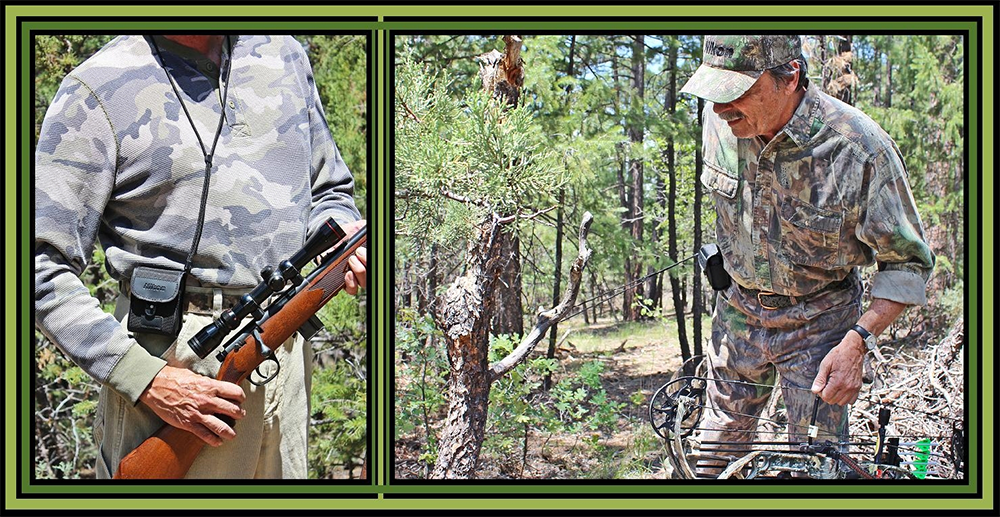
- Control Positioning – The M-3000-S mode button has been repositioned atop the unit, in tandem with the on/off/ranging button. I’m not sure what prompted this change from the M-7i VR’s side-mounted mode button, but this has created a problem for long fingered/large handed/gloved fingered users. When holding the small M-7i VR, the on/off/ranging button was perfectly positioned precisely under the index finger. Now with 2 buttons atop the smaller M-3000-S, it’s much harder to locate the action button by feel, and I find that I often press on the area between the two buttons.

- Eye Relief – The #2 complaint from purchasers of the new M-3000-S is difficulty in positioning the eye behind the ocular to obtain a full field-of-view. Eyeglass wearers don’t seem to be affected but with bare eyes, some spacing is required for a full view, and it’s difficult to maintain precise spacing while hand-holding and activating the unit. This problem could be solved with an adjustable eyepiece similar to those found on binoculars, or more simply with a collapsible, soft rubber eyecup that would maintain proper spacing through resistance, when pressed against the eye socket.
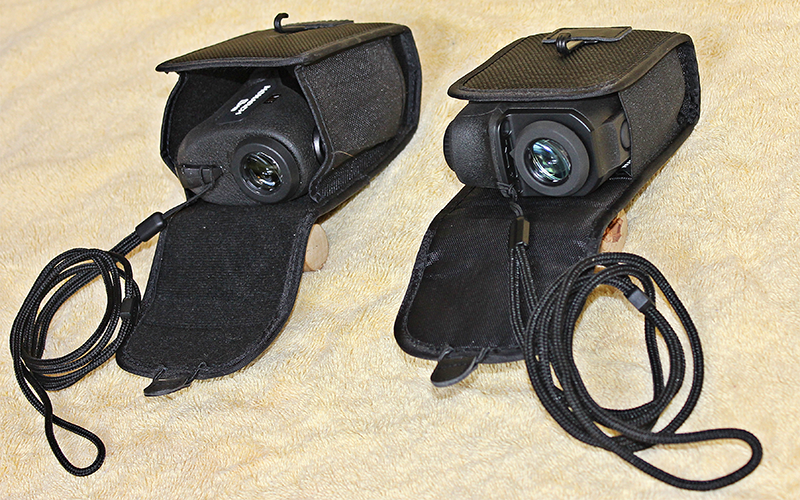
- False Advertising – The #1 complaint from purchasers of the new Monarch 3000 Stabilized rangefinder is that it does not measure the advertised distance(s). Nikon has published the following “maximum measurement” distances: 3000 yards for reflective targets, 1100 yards for trees, and 1000 yards for deer, with the caveat that these are “reference values… under Nikon’s measurement conditions.” Really? Well I killed a 400-inch mule deer… under Tony’s measurement conditions! Frankly, I don’t understand how outrageous measurement claims under special “conditions” benefit anyone. Here’s more Nikon advertising: “With an effective range of nearly 2 miles (3,000 yards) on reflective targets, we’ve tripled the ranging capability compared to our award-winning, image-stabilized laser rangefinder introduced last year.” This is simply untrue. The M-7i VR is not a 1000-yard rangefinder, and the M-3000-S does not have an “effective range” of 3000 yards.
In this day and age of “fake news” and zero accountability, misleading and even false performance claims are not surprising. Let’s give Nikon credit for being one of the last rangefinder companies to “go with the flow” and switch from advertising the lesser, functionally effective range to the greater, maximum measurement range for highly reflective surfaces – which happened about 7-1/2 years ago. Hunters hunt animals, which are not highly reflective targets. In my opinion, it’s high time to pull back on the reins and set a new standard for truth in rangefinder marketing, by advertising true functional measurement distances that hunters can expect to duplicate in the field.
SUMMARY
The ultimate assessment after testing is whether I would purchase and/or recommend the Nikon Monarch 3000 Stabilized Laser Rangefinder… or not. The answer is a resounding yes! This unit is an excellent value, with features that are not available in other rangefinders. It can be expected to function very well in most applications for bow, rifle and dual-purpose hunting, with the exception of the longest, long-range hunting. It will also function well in target shooting applications out to distances of one-half mile.




Leave a Reply